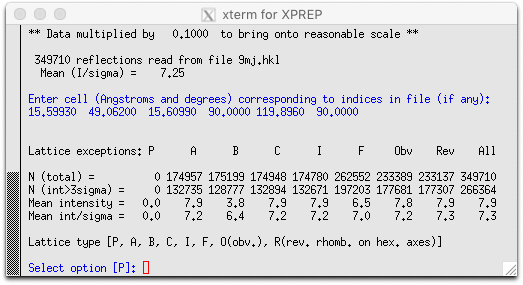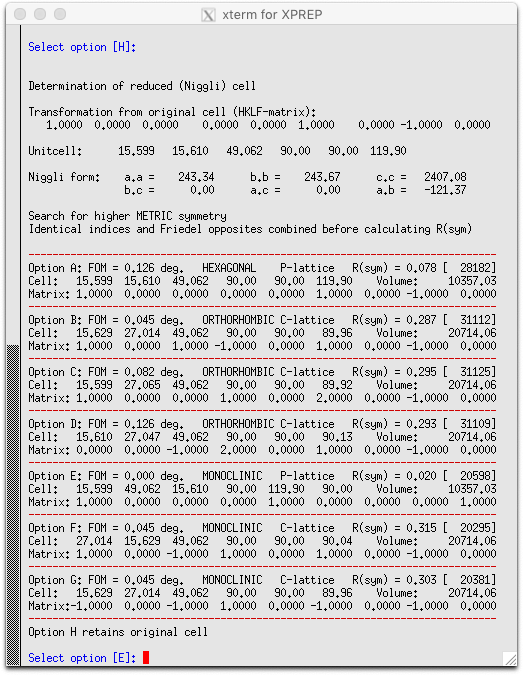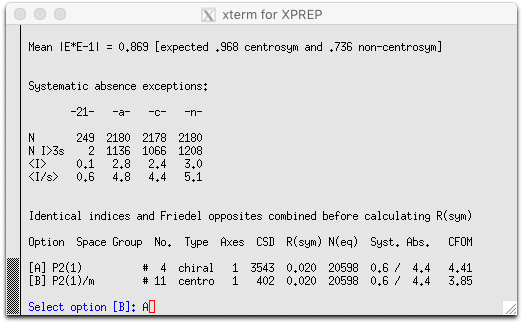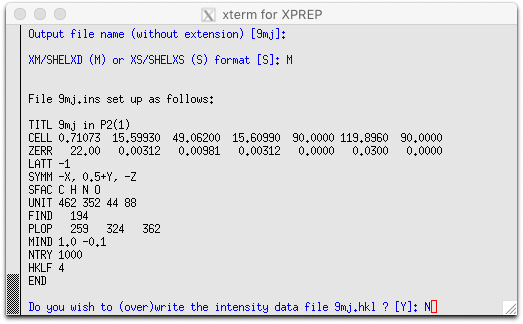
Nothing too extraordinary there. The data give every indication of a primitive cell,
and at this stage there's no reason to suspect anything unusual. The keen-eyed reader,
however, might notice that the 'mean intensity' and 'int/sigma' in the 'B' column are a
bit lower than for the other centering conditions. Since pseudo-centering is not uncommon,
we'll accept the default (primitive, P) cell. Next up is to check for higher symmetry.
The program suggests seven cells:

Not surprisingly, the first suggestion is to transform to a hexagonal setting. In the
list, only options A and E have R(sym) values that are small enough to consider.
The R(sym) for monoclinic P (option E), however, is so much better than
R(sym) for hexagonal P (option A), that the program suggests it as the
default. Note that this is the same cell we entered earlier. The next task is to assign
a space group. After tapping through a few prompts in XPREP, we get the following:

Since we already know that the compound is chiral and enantiopure, we can dismiss
P21/m, which leaves only P21. For the time being,
this is the best we can do. Here again, we'll skip through a few XPREP screens
to the point where we set up instructions to solve the structure. Bear in mind that
solving this structure using P21 is not correct, but it should
provide a pathway to the correct structure. Since it is twinned, SHELXT, will not
work: it simply grinds away for ages and eventually spits out garbage (try it if you like).
So we'll choose [M] to generate an ins file for SHELXD, as follows:

We already have the dataset (9mj.hkl) and since we didn't transform the unit cell, there's
no need to (over)write the hkl file. As an aside, the original hkl file (from
SADABS) is always preferable: it contains more information than an hkl file
written by XPREP. That's because XPREP scales all the numbers down and strictly
applies the F8.2 format to F2 and σ(F2) values,
which reduces precision for weak reflections (try a side-by-side comparison of hkl files
from both SADABS and XPREP to see the difference).
In the next section, we'll edit the above 9mj.ins file to include a second twin component
(SHELXD does not yet allow for more than two twin components) and fix the wavelength,
amongst other things. We now exit XPREP and proceed to part 3, where we'll attempt to get
a chemically reasonable model using the conventional setting of P21.
1: Introduction
2: Set up instructions using XPREP
3: Solve using P21 with SHELXD
4: Detwin using SHELXL
5: Analyze detwinned dataset using XPREP
6: Three-fold twinning in graphic detail
7: Solve using B21 with SHELXD
2: Set up instructions using XPREP
3: Solve using P21 with SHELXD
4: Detwin using SHELXL
5: Analyze detwinned dataset using XPREP
6: Three-fold twinning in graphic detail
7: Solve using B21 with SHELXD